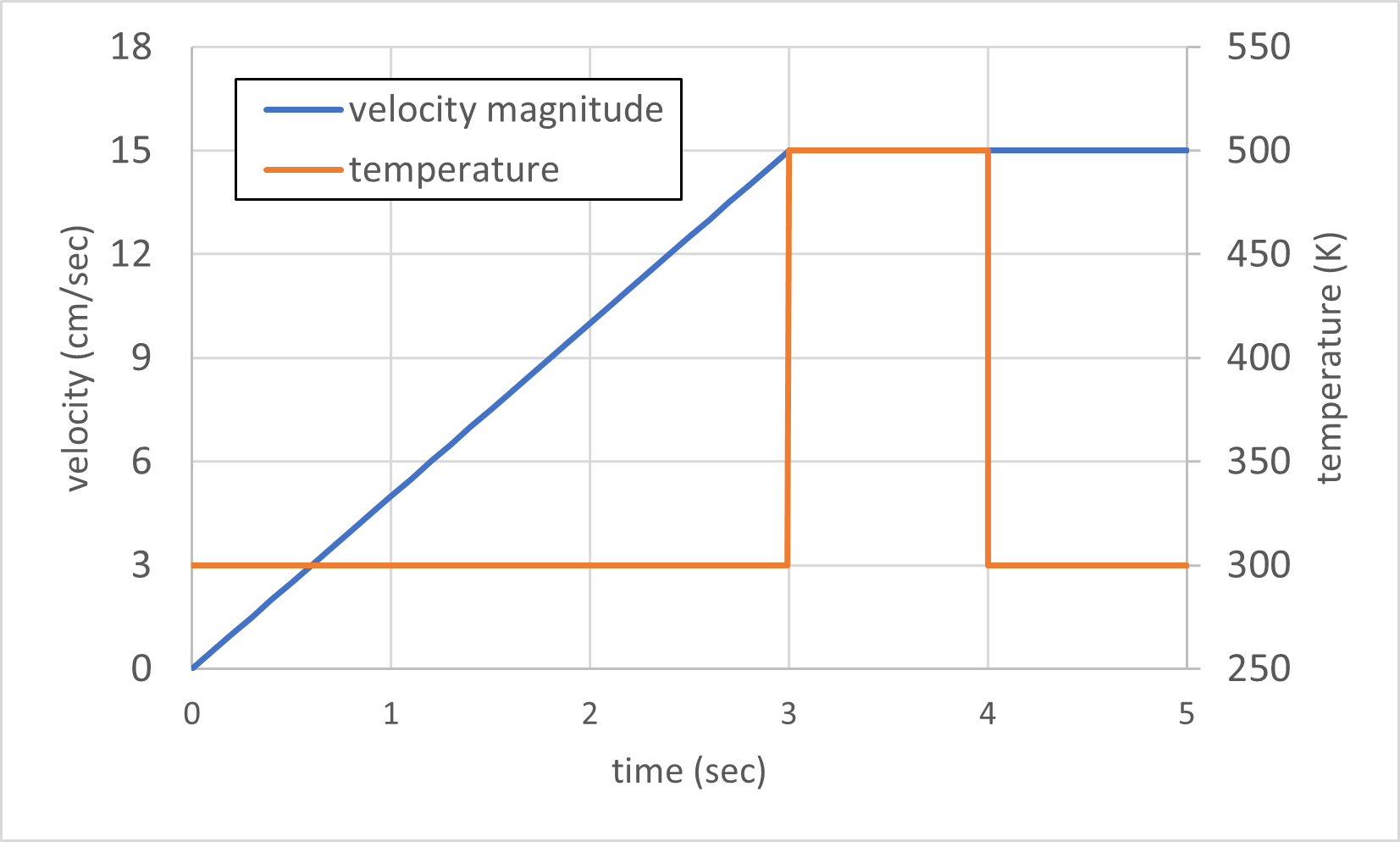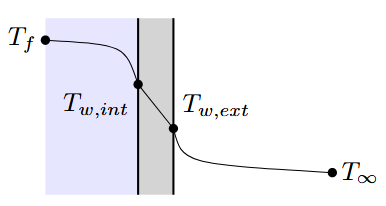Boundary conditions
General boundary conditions
The following inputs are defined using the prefix bc:
Description |
Type |
Default |
|
|---|---|---|---|
regions |
Regions used to define boundary conditions. |
Strings |
None |
delp_dir |
Direction for specified pressure drop. Note that this direction should also be periodic. |
Int |
0 |
delp |
Pressure drop (Pa) |
Real |
0 |
po_no_par_out |
Force particles to bounce back rather than exiting at pressure outflows. |
Int |
0 |
The type of the boundary conditions in the BC region must be defined with the prefix bc:
Description |
Type |
Default |
|
|---|---|---|---|
[region_name] |
Specify boundary condition type. Options:
|
String |
None |
Fluid settings
For each boundary condition region, the fluid inputs are defined
using the prefix bc.[region_name].[fluid_name]:
Description |
Type |
Default |
|
|---|---|---|---|
volfrac |
Volume fraction [required if bc type is |
Real |
0 |
density |
Fluid density [required if bc type is |
Real |
0 |
pressure |
Fluid pressure [required if bc type is |
Real |
0 |
temperature |
Fluid temperature [required if bc type is |
Real |
0 |
velocity |
Velocity components [required if bc type is |
Reals |
0 0 0 |
volflow |
Volumetric flow rate [required if bc type is |
Real |
0 |
massflow |
Mass flow rate [required if bc type is |
Real |
0 |
species.[species_name] |
Species species_name mass fraction [required if solve_species`=1
and bc type is ``mi` or |
Real |
0 |
Note that for a mi only one of velocity or volflow or massflow should be specified.
Additionally, velocity can be specified as a vector or a scalar, the latter of which is applied
normal to the inflow plane, as with volflow and massflow.
Below is an example for specifying boundary conditions for fluid (fluid).
bc.regions = inflow outflow
bc.inflow = mi
bc.inflow.fluid.volfrac = 1.0
bc.inflow.fluid.density = 1.0
bc.inflow.fluid.velocity = 0.015 0.0 0.0
bc.inflow.fluid.temperature = 300
bc.inflow.fluid.species.O2 = 0.0
bc.inflow.fluid.species.CO = 0.5
bc.inflow.fluid.species.CO2 = 0.5
bc.outflow = po
bc.outflow.fluid.pressure = 0.0
Below is an example for specifying a normal inflow velocity magnitude for a region eb-flow.
bc.regions = eb-flow
bc.eb-flow = eb
bc.eb-flow.my_fluid.volfrac = 1.0
bc.eb-flow.my_fluid.velocity = 0.1
Below is an example where only specific cells are imposed a velocity inflow in the x-direction.
bc.regions = eb-flow
bc.eb-flow = eb
bc.eb-flow.eb.normal_tol = 3.0
bc.eb-flow.eb.normal = 0.9848 0.0000 0.1736 # 10 deg
bc.eb-flow.my_fluid.volfrac = 1.0
bc.eb-flow.my_fluid.velocity = 0.1 0.0 0.0
Solids settings
For each inflow boundary condition region, general solids inputs are defined using the prefix bc.[region_name]:
Description |
Type |
Default |
|
|---|---|---|---|
solids |
Name of solid type in BC region. Only one solid is allowed in an BC region. |
String |
None |
Warning
Mass inflow boundary conditions, bc.[region_name] = mi, only support PIC parcels. EB inflow boundary conditions,
bc.[region_name] = eb, support DEM particles and PIC parcels.
For inflow boundary conditions , the solid inputs are defined using the prefix bc.[region_name].[solid_name]:
Note that diameter distributions must define a weighting type,
please refer to ReferenceParticleDistributions.
Description |
Type |
Default |
|
|---|---|---|---|
volfrac |
Volume fraction |
Real |
0 |
temperature |
Temperature |
Real |
0 |
species.[species_name] |
Mass fraction of |
Real |
0 |
velocity |
Velocity components |
Reals |
0 0 0 |
volflow |
Volumetric flow rate. |
Real |
0 |
massflow |
Mass flow rate. |
Real |
0 |
diameter |
Method to specify particle diameter in the IC region. This is only used for auto-generated particles. Options:
|
String |
None |
type |
Distribution weighting. Options:
|
String |
N/A |
bins |
Number of bins used when discretizing the distribution to approximate the number of particles within an initial condition region. |
Int |
64 |
diameter.constant |
Monodisperse (single valued) particle diameter.
Required for |
Real |
0 |
diameter.mean |
Distribution mean.
Required for |
Real |
0 |
diameter.std |
Distribution standard deviation.
Required for |
Real |
0 |
diameter.min |
Minimum diameter to clip distribution.
Required for |
Real |
0 |
diameter.max |
Maximum diameter to clip distribution.
Required for |
Real |
0 |
diameter.custom |
File name that specifies either the cumulative or probability
distribution. Required for |
String |
None |
density |
Method to specify particle density in the IC region. This is only used for auto-generated particles. Options:
|
String |
None |
density.constant |
Monodisperse (single valued) particle density.
Required for |
Real |
0 |
density.mean |
Distribution mean.
Required for |
Real |
0 |
density.std |
Distribution standard deviation.
Required for |
Real |
0 |
density.min |
Minimum diameter to clip distribution.
Required for |
Real |
0 |
density.max |
Maximum diameter to clip distribution.
Required for |
Real |
0 |
density.custom |
File name that specifies either the cumulative or probability
distribution. Required for |
String |
None |
Transient boundary conditions
Velocity, temperature, and pressure boundary conditions may also be specified as a function of time simply by adding a new column. The time value is entered in the new first column. We can make the mi boundary condition above time-dependent by replacing:
bc.inflow.fluid.velocity = 0.0 0.0 0.0 0.0
bc.inflow.fluid.velocity = 3.0 0.015 0.0 0.0
bc.inflow.fluid.temperature = 0.0 300
bc.inflow.fluid.temperature = 2.99 300
bc.inflow.fluid.temperature = 3.0 500
bc.inflow.fluid.temperature = 4.0 500
bc.inflow.fluid.temperature = 4.01 300
In the above example, the inflow velocity is accelerated from zero to its final value over a period of three seconds. Linear interpolation is used in between discrete time values and held constant at the last time value. The temperature sees an abrupt spike from 300 up to 500 at t = 3s and then back down again after 4s. Note that the timestep is not adjusted to sync with transient BCs.

Thermal boundary conditions
Boundary conditions can be applied to embedded boundaries (EBs). For example, a constant wall temperature can be imposed on the entire EB or restricted to a specific region.
To apply a boundary condition to only a portion of an EB, a face normal vector and tolerance can be specified. This
allows the condition to be applied only to EB faces whose normals align with the specified direction within a given
angular tolerance. The following inputs are defined using the prefix bc.[region_name].eb:
Description |
Type |
Default |
|
|---|---|---|---|
normal |
[Optional] Specifies the target face normal direction. Only EB faces whose normals are parallel (within the specified tolerance) will have the boundary condition applied. |
Reals |
0 0 0 |
normal_tol |
[Optional] Angular tolerance (in degrees) used with |
Real |
0 |
The following table lists the thermal boundary condition options that can be applied to embedded boundaries (EBs), with
inputs defined using the prefix bc.[region_name].eb.
Description |
Type |
Default |
|
|---|---|---|---|
temperature |
Specify a wall temperature model for the embedded boundary. Options:
|
String |
adiabatic |
temperature.constant |
Constant wall temperature.
A valid is required for |
Real |
None |
The conjugate heat transfer model approximates heat transfer through the embedded boundary using one-dimensional, steady-state conduction. The external environment is treated as a thermal reservoir with a constant temperature in both space and time. This approach is illustrated in Fig. 9, where heat flows through a series of thermal resistances: from the fluid to the inner wall surface, through the wall, and finally to the environment. The direction of heat transfer—into or out of the system—is governed by the temperature gradient between the fluid and the surroundings.

Fig. 9 Schematic of the conjugate heat transfer boundary condition.
An effective resistance is calculated based on the convective heat transfer coefficient between the fluid and wall, \(h_{int}\), conduction through the wall with thickness \(L_w\) and thermal conductivity \(\kappa_w\), and convective heat transfer from the exterior wall to the environment \(h_{ext}\).
The interior wall temperature is determined by balancing the heat flux contributions from internal convection, wall conduction, and external convection, resulting in a closed-form expression based on the effective thermal resistance of the system.
The model settings are defined using the prefix bc.[region_name].eb.temperature.CHT-1D:
Description |
Type |
Default |
|
|---|---|---|---|
T_env |
Environment temperature |
Real |
None |
h_int |
Heat Transfer Coefficient (fluid–wall, internal) Specifies the convective heat transfer coefficient [W/m² K] between the fluid and adjacent solid walls (EBs) located within the interior of the computational domain. |
Real |
None |
h_ext |
Heat Transfer Coefficient (wall-environment, external) Specifies the convective heat transfer coefficient [W/m² K] between the wall and the external environment. |
Real |
None |
wall.conductivity |
The thermal conductivity of the wall. |
Real |
None |
wall.thickness |
Wall thickness. |
Real |
None |
phase_averaged_temperature |
Use a phase averaged temperature for simulations containing particles. The phase averaged temperature is computed as the volume fraction weighted sum of the fluid and averaged particle temperatures.
The averaged particle temperature is computed by depositing the volume-averaged particle temperature to the grid.
|
Bool |
false |
Below is an example for specifying a constant temperature boundary condition in the hot-walls region.
bc.regions = hot-wall
bc.hot-walls = eb
bc.hot-walls.eb.temperature = constant
bc.hot-walls.eb.temperature.constant = 800